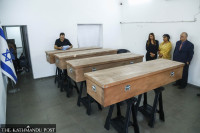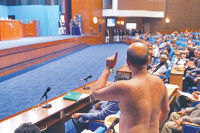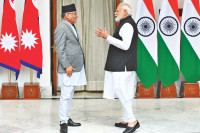Special Supplement
Year of Elections but a lot more
When we look back at 2017, it will be remembered, more than anything else, as a year when Nepal turned a political leaf. Despite deep foreboding in various quarters, we successfully conducted elections to three tiers of government—753 local bodies, seven provincial assemblies and a federal parliament.
When we look back at 2017, it will be remembered, more than anything else, as a year when Nepal turned a political leaf. Despite deep foreboding in various quarters, we successfully conducted elections to three tiers of government—753 local bodies, seven provincial assemblies and a federal parliament. The election cycle marked an important milestone in completing a prolonged political transition into a federal democratic republic, a process that started in 2006.
The Chief Election Commissioner, Ayodhi Prasad Yadav, and two of his predecessors—Bhojraj Pokharel in 2008 and Neelkantha Upreti in 2013—conducted successful elections in adverse circumstances. It’s a Himalayan wonder how easily things fall into place when Nepal’s ever-warring political parties put their minds into something. Look what happened in 2005-06—the 250-year-old monarchy became history.
Yet it was hardly an easy election cycle. There were serious security threats, a mountain of election logistics to climb, and close to 1.4 million voters for local, federal parliament and provincial assembly elections. The task was made even more difficult this time, with elections running deep into the winter.
Yet the figures speak for themselves. There was a handsome voter turnout in both the local elections, and elections for the provincial and federal parliament—74 percent and 70 percent.
In our year-ender, we have tried to put faces to these historic elections (“Making Milestones”) and many other noteworthy events that took place in 2017. But we have also been careful to point out that the 2017 elections actually mark a regression as far as women’s candidature in the First-Past-the-Post race is concerned (“Double Speak”). It was in order to promote inclusion and address underrepresentation of women and other marginalized groups that a mixed mode electoral system, with FPTP and Proportional Representation elections, were introduced in 2008. But only six women—all notably from left of the political spectrum—were elected through the FPTP tickets. The political parties will now fill the constitutional requirement of 33 percent women representation in the two houses of federal parliament through PR nominations.
This year, many people found the news of the electoral alliance between the UML and the Maoist Centre hard to believe, but in “Love-hate Couple” we explore how the Left Alliance has been one of the biggest political events of recent Nepali history.
The year also saw a number of high-profile corruption scandals surface, once again highlighting the dirty nexus between criminals and political heavyweights (the latest saga involves the controversial businessman Ajey Sumargi in money laundering and protection provided to him by Maoist Centre Chairman Pushpa Kamal Dahal, among others). The good news is that these scandals are being reported in the media with greater depth and dexterity. In the “Biggest Corruption Case in Nepal’s history”, we report how the anti-corruption watchdog, the CIAA, has regained some public trust after it initiated action against tax officials with questionable backgrounds.
Then there are some stories of individual brilliance. “The Risk Taker” is about the National Planning Commission vice-chairman, Swarnim Wagle and how he struggled to make a career choice as a teenager—nervous about making a switch to economics. Now he is driven by a singular desire to work for the Nepal government in order to affect change.
We also cover two young entrepreneurs. “Ride Along” is a story about a brand-new ride sharing app, Tootle, and how its proponent Sixit Bhatta and his team are changing the way Kathmandu commutes on two-wheelers. In ”A Paper Trail”, we write about how when Bhintuna “Jya-Poo” started her stationary line—Bhav—she was only trying to fill a void in the Nepali market, but in three short years has built a stationary empire.
In our arts section, we cover two very talented women. Gunjan Dixit is a woman determined to stand tall in the theatre world dominated by the male voice (“Theatre Reborn”).
Nepal also lost one its best and the brightest this year. Dina Bangdel, 52, was recognized among a handful of people performing the extraordinary task of informing the global art market of Nepal’s contemporary art practices (“An immeasurable loss”).
We hope you will enjoy our year-ender and we wish you a happy New Year.
Akhilesh Upadhyay
Editor-in-Chief
The Kathmandu Post




 10.12°C Kathmandu
10.12°C Kathmandu







%20(1).jpg&w=300&height=200)

